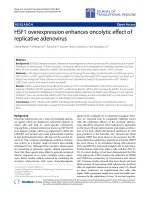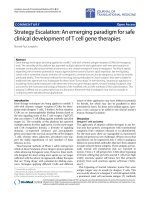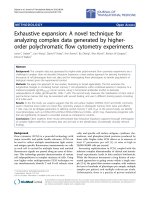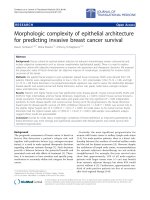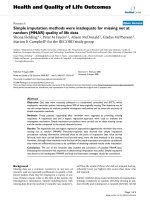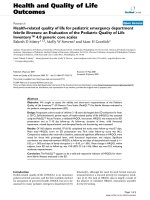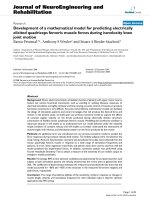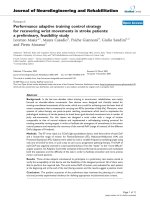Báo cáo hóa học: " Feedback-based adaptive network coded cooperation for wireless networks" potx
Bạn đang xem bản rút gọn của tài liệu. Xem và tải ngay bản đầy đủ của tài liệu tại đây (557.95 KB, 15 trang )
RESEARCH Open Access
Feedback-based adaptive network coded
cooperation for wireless networks
Kaibin Zhang
1*
, Liuguo Yin
2
and Jianhua Lu
1
Abstract
A novel feedback-based adaptive network coded cooperation (FANCC) scheme is proposed for wireless networks
that comprise a number of terminals transmitting data to a common destination. The proposed FANCC exploits
network coding and matches code-on-graph with network-on-graph, which is a substantial extension of adaptive
network coded cooperation (ANCC). In the relay phase of FANCC, the terminal will be active when its channel
fading coefficient magnitude |h| is larger than the threshold T
th
and the broadcast-packet of one terminal will be
possibly selected for check-sum wh en |h| is less than the threshold R
th
. In the indication phase, the destination
broadcasts above message at cost of 2 bits per terminal. Therefore, distributed fountain codes are generated at the
destination. Both achievable rates and outage probabilities are evaluated for FANCC and closed-form expressions
are derived when the network size approaches infinity. Moreover, compared with ANCC, analysis results
demonstrate that FANCC achieves 1-2 dB performance improvement at the outage probability of 10
-6
and 1-2 dB
gain at the same achievable rate and the simulation results shows that FANCC has better Frame error ratio (FER)
performance.
Index Terms–cooperative wireless network, network coding, fountain codes, distributed coding
I. Introduction
The random fading in wireless networks has posed a
fundamental challenge to maintain excellent perfor-
mance under lossy conditions. User cooperation, first
discussed by vander Merlrn in 1971 [1], involves the
deliberate permission of one or more cooperating nodes,
known as the relays, into the conventional point-to-
point communication link. Hence, a number of single-
antenna users share their antennas and transmit infor-
mation jointly as a virtual MIMO system, which enables
them to obtain higher data rates and extra diversity
than when they operate individually.
Exploiting wireless network coding [2,3] in user
cooperation, adaptive network coded cooperation
(ANC C) [4,5] fully exploits the spatial diversity in dis-
tributed terminals and re dundancy residing in channel
codes, which is composed of two phases: broadcast
phaseandrelayphase.Inthebroadcastphase,each
terminal broadcasts its own data (broadcast-packet)
and the others which keep silent decode the received
packets. In the relay phase, each terminal randomly
selects several correctly-decoding packets to form the
check-sum (relay-packet), then relays it to the destina-
tion. Hence, matching the instantaneous network
topologies, ANCC adaptively generates an ensemble of
low-density parity-check (LDPC) codes [6,7] in a dis-
tributed manner at the destination. Using the message-
passingdecodingalgorithmat the destination, ANCC
shows much more excellent performance than the
repetition-based cooperation frameworks [8] and
Space-Time Coded Cooperation (STCC) schemes [9].
Despite source-destination channel quality, ANCC pro-
tocol allows all the broadcast-packets to be selected for
relay-packets and all the terminals to attend relaying,
which provides equal error protection to all the term-
inals. However, terminals with poor source-destination
channel, intuitively need more error protection pro-
vided by coded cooperation. Thereby, ANCC which
doesn’ t exploit the source-destination channel state
information, is a subop-timal solution to the end-to-
end performance because it only considers the term-
inal-terminal cooperation other than overall
cooperation.
* Correspondence:
1
Department of Electronic Engineering, Tsinghua University, Beijing, 100084
P. R. China
Full list of author information is available at the end of the article
Zhang et al. EURASIP Journal on Wireless Communications and Networking 2011, 2011:164
/>© 2011 Zhang et al; licensee Springer. This is an Open Access article distributed under the terms of the Creative Commons Attribution
License ( which permits unrestricted use, distribution, and reproduction in any medium,
provided the original work is properly ci ted.
Inherent to network c ommunication is the coopera-
tion among different users which pulls together all
dimensions of resources [3,10]. Recently a numbe r of
papers have been published, proposing information
exchange protocols between destination and terminals
[11-13]. References [ 11,12] analyze the performance of
opportunistic relaying protocols which employ simple
feedback from the receivers, but network coding is not
adopted. Another study proposes an opportunistic net-
work coded cooperation scheme for small networks
[13]. To achieve a potential larger diversity gain of large
wireless networks, in this paper, we propose Feedback-
based network coded cooperation (FANCC).Compared
with ANCC, between broadcast phase and relay phase,
FANCC adds indication phase. In the indication phase,
the destination broadcasts the following knowledge,
which costs 2 bits per terminal: the broadcast-packets
transmitted in the channel whose |h|islessthan
R
th
=
ln
m
m −l
could be selected for check-sums
and the terminal whose |h|islargerthan
T
th
=
ln
m
s
is permitted to relay the relay-packets,
where m is the network size, 0 ≤ s ≤ m an d 0 ≤ l ≤ m.
Thus, distributed fountain codes with unequal error
protection matching channel quality are generated in an
efficient and practical manner.
Obviously, FANCC subsumes ANCC as its degener-
ated case when both l and s are equal to the network
size m. Intuitively, the feedback from the destination
helps FANCC make efficient use of the degree o f free-
dom of the channel. Furthermore, we analyze the infor-
mation-theoretic results of each source-destination
channel: achievable rate and outage probability. In the
limiting case when m approaches infinity, closed-form
expressions for achievable rate an d outage probability
are derived for FANCC. For any finite network where
theexpressionofoutageprobability is hard to simplify,
we perform the numerical evaluation. From the analysis
results, the achievable rate of FANCC has no relation to
l and increases with the decrease of s. The out age prob-
ability improves with the decrease of l for fixed s and
decreases with the increase of s fo r fixed l. Despite the
network size, our analysis demonstrates that FANCC
has superior performance over ANCC. Finally, simula-
tion results also verify that FANCC is more effective
than ANCC.
The rest of the paper is organized as follows: Section
II briefs the system model of interest and ANCC. Sec-
tion III provides FANCC protocol, and Section IV ana-
lyzes the achievable rate and outage probability for
FANCC, then gives numerical and simulation results.
Finally, Section V draws the conclusion.
II. System model and ANCC
A. System model
The system model discussed in this paper comprises m
terminals wirelessly transmitting data to a common des-
tination. We assume that all the communication chan-
nels here are orthogonal in frequency, time or spread
code and are subject to frequency nonselective fading.
The fading coefficient h is modeled as a zero-mean,
independent, circularly complex Gaussian random vari-
able with unit variance. The magnitude |h| is Rayleigh
distributed and the probability density function (pdf) of
the channel power μ =|h|
2
is p
u
(x)=e
-x
. The channel
noise Z accounts for the addictive channel noise and
infere nce, which is modeled as a complex Gaussian ran-
dom variable with variance N
0
.
For each transmission, terminal i sends binary phase-
shift keying (BPSK) modulated data b(n)withthetrans-
mitted energy per bit E
i
at time n. Thereby the discrete-
time signal transmitted by terminal i is modeled as
√
E
i
· b(n)
. The corresponding signal received by term-
inal j Î {0,1,2 · · · m}(j ≠ i, j = 0 represents the destina-
tion) is
r
i,j
(n)=h
i,j
s
i
(n)+z
i,j
(n)
(1)
where z
i,j
(n) is the channel noise between terminal i
and j. We assume that the mean of the signal-to-noise
ratio (SNR) between terminals and the destination is the
same and the mean of SNR between terminal i and the
destination is
γ
i,0
= E
h
i
,0
[
h
2
i,0
(n)E
i
z
i,j
(n)
]=
E
i
N
0
(2)
We also consider that the receivers can maintain
channel state information (CSI) but the transmitters
not. Furthermore, we assume that the fading coef ficient
h keeps constant in one round of data transmission , but
changes independently from one to another.
B. Adaptive Network Code Cooperation
From recent literatures, network coding is applied to a
cooperative wireless network where a relay node plays
the role of the network coding node which mixes the
information received from other nodes and airs the
coded ones, which can improve the overall system
performance.
Exploiting the network coding technology, ANCC
adapts to the c hanging network topology to combat the
wireless fading, which significantly outperforms
Zhang et al. EURASIP Journal on Wireless Communications and Networking 2011, 2011:164
/>Page 2 of 15
repetition-based cooperation schemes and space-time
coded cooperation frameworks.
The strategy proceeds as follows. In the broadcast
phase, each terminal transmits its broadcast-packet in
the orthogonal channel and all the others listen and
decode what it hears. Due to the channel random fad-
ing, a terminal may not decode all the broadcast-packets
successfully. Here, retrieval-set
(i)
denotes the assem-
ble of broadcast- packets which are correct-decoding for
terminal i,where
(i) ⊂{1, 2, ···, m}
.Intherelay
phase, each terminal randomly selects a small, fixed
number d of broadcast-packets from its retrieval-set,
and calculates its relay-packet by XORing those packets
symbol by symbol in the binary domain, then airs the
results to the destination.
Thereby, through each round of broadcast and relay
phase, a (2m, m) distributed network code in the form
of a random, systematic, degree-d low-density generate-
matrix (LDGM)
a
code, is generated at the destination.
The systematic bits of the distributed LDGM co de com-
prises the broadcast-packets transmitted in t he broad-
cast phase, the parity bits are formed of the relay-
packets sent in the relay phase.
Due to the random construction of the distributed
code, the knowledge that how the relay-packets are
formed (selection indication) is included in the head of
each relay-packet. Matching the instantaneous code
grap h, the destination will generate an ad aptive decoder
to perform message-passing decoding algorithm, which
can be implemented by software radio [14]. To sum up,
the ANCC protocol is shown in Figure 1.
It is clear that different selections of the subset of
(i)
result in different distributed LDGM codes.
Take a cooperative wireless ne twork for an example,
where 6 terminals, S
1
to S
6
.Ifterminalj decodes suc-
cessfully the packet from source i, a directed edge, i to j,
is generated. In one communication round, the instanta-
neous network topology is illustrated in Figure 2 (desti-
nation is not shown in Figure 2). The retrieval-set
(i)
of each terminal is, respectively,
(1) = {1, 2, 4},
(2) = {1, 2,4,5,6},
(3) = {1, 2, 3,4,6},
(4) = {1,3,4,5,6},
(5) = {1, 2, 4, 5,6},
(6) = {1, 2, 3, 5, 6}.
Every bo ld font numeral represents the termina l
whose broadcast-packet is selected to form the check-
sum in the relay phase. Hence, the corresponding parity
check matrix of the distributed LDGM code is obtained:
H =
systematic bits
⎛
⎜
⎜
⎜
⎜
⎜
⎜
⎝
110100
110001
011001
100101
100110
001011
parity bits
100000
010000
001000
000100
000010
000001
⎞
⎟
⎟
⎟
⎟
⎟
⎟
⎠
(3)
III. Feedback-based adaptive network coded
cooperation(FANCC)
A. The traditional fountain codes
In this section, before proposing FANCC, we first intro-
duce the traditional LT codes invented by Luby [15].
Suppose that a message contains n input symbols should
be sent. Hence, the encoding process works as follows:
1) randomly select a degree d from the distributed
function.
2) Uniformly choose random d symbols
3) Xoring the d symbols into a check symbol, trans-
mitting it forward to the destination.
4) repeat above three process until the destination
receives enough check symbol to recover all input
symbols.
Clearly, the traditional rateless codes select the input
symbols at the same probability and have equal error
protection for all information.
1
2
3
Broadcast phase
Relay phase
//Time Frequenc
y
Spread Code
m
broadcast packe
t
%%
#
relay packet
s
election indication
m
Figure 1 Adaptive network coded cooperation (ANCC) protocol.
Zhang et al. EURASIP Journal on Wireless Communications and Networking 2011, 2011:164
/>Page 3 of 15
From the encoding process, we may treat the input
and check symbols as vertices of a bipartite graph which
is similar to an LDPC code. Therefore, the input sym-
bols are information bits and the check symbols are the
check bits. The decoding process of LT codes repeatedly
uses the following simple recovery rule: Find any equa-
tion with exactly one variable, recover the value of the
variable by setting it equal to the value of the equation,
and then remove the newly recovered variab le from any
other equations that it appears in by exclusive-oring its
value into each of these equations. For example, con-
sider the fountain code with equations y
1
= x
3
, y
2
= x
2
⊕ x
3
, y
3
= x
3
⊕ x
1
and y
4
= x
4
⊕ x
2
⊕ x
1
.Andthe
decoding process is shown as follows:
1) we obtain the value of x
3
from the equation y
1
= x
3
.
Then, we XOR the equation y
2
and y
3
with x
3
and yield
new equation
˜
y
2
= x
2
and
˜
y
3
= x
1
.
2) Thus, we recover the value of x
2
from
˜
y
2
= x
2
.The
new value of x
2
is substituted into y
4
to achieve the new
simplified equation
˜
y
4
= x
4
⊕ x
1
.
3) Then, we get the value of x
1
from
˜
y
3
= x
1
and XOR
it into
˜
y
4
yielding the new simplified equation
y
4
= x
4
.
4) At last, we recover the value of x
4
from
y
4
= x
4
.
B. The Basic Idea of FANCC
The greatest cooperation among different users can pu ll
together all dimensions of communication resources
efficiently (i.e. time, frequency, spread code or terminal
etc.). The more understanding users play with, the
greater diversity the system gets. The ANCC protocol
takes advantage of the cooperation between terminals
but not between terminals and the destination. Utilizing
each source-destination channel state information
obtained at the destination for resource management, it
is evident to produce additional cooperative benefits.
Furthermore, terminals never stop relaying unless the
destination successfully decodes all the broadcast-pack-
ets if the system complexity is not considered, that is to
say, a rateless code is generated from the view of the
destination [16]. However, two advanced protocols men-
tioned above are too complex to be practical. Based on
above discussion, our idea finds its intuitive motivation
that more data can be transmitted in good channels and
the broadcast-packets in bad channels should require
greater protection of relay-packets in the distributed
codes, which is in line wit h the classic information the-
ory. In this paper, we propose Feedback-based adaptive
network coded cooperation (FANCC),whichmakesuse
of the indexed feedback from the destination to indicate
which terminals’ broadcast-packets to form the check-
sum and which terminals to transmit the relay-packets
in the relay phase.
Figure 3 demonstra tes the FANCC strategy in detail.
The specific process works as described below:
In the broadcast phase, each terminal broadcasts its
broadcast-packet in its orthogonal channel while the
others keep silent and decode what it hears, which is
the same as that in ANCC.
Figure 2 an i nstantaneous network topology of 6 terminals
communicating to a common destination (not shown).
Figure 3 Feedback-based adaptive network coded cooperation(FANCC) protocol.Aboutm-lbroadcast-packets can be allowed to be
selected to form check-sum and about s terminals will be active in the relay phase.
Zhang et al. EURASIP Journal on Wireless Communications and Networking 2011, 2011:164
/>Page 4 of 15
In the indication phase, the destination uses trans-
mission indication, T and relay indication, R, where T is
alength-m vector and every element is ‘0’ or ‘1’, as well
as R. Here, T(i) = 1(1 ≤ i ≤ m) denotes that the terminal
whose |h|islargerthan
T
th
=
ln
m
s
and terminal i
will transmits the check-sum in the relay phase. Like-
wise, R(i)=1(1≤ i ≤ m) means that terminal i whose |
h|islessthan
R
th
=
ln
m
m −l
and its broadcast-
packet is allowed to be selected to form the check-sum,
where m is the number o f terminals. In this phase, the
destination broadcasts R, T to each terminal. l is
select ed to guarantee the broadcast packets error free in
the channels where
|h| >
ln
m
m −l
and s satisfies
the condition m -l ≤ s ≤ m.Hereweassumethatthe
feedback process is free of error, which is similar to
relay selection indication transmission in ANCC.
In the relay phase,forterminali,ifT(i)=1,itran-
domly selects d broadcast-packet s of terminals {j
1
, j
2
,
, j
d
}, where
j
k
⊂(i)
and R (j
k
)=1(1≤ k ≤ d),
XORs them from symbol by s ymbol and conveys the
result to the destination in the orthogonal channel. For
example, in Figure 3, the broadcast-packet of terminal
3 can no t be selected for check-sums and terminal s
except terminal 2 transmit the relay-packet in the relay
phase.
For one communication round, we assume that there
are k
1
1s in T and k
2
1s in R. Thus a distributed (k
1
,
2m) fountain code is produced, whose parity check
matrix has m - k
2
zero columns, that is to say, m - k
2
broadcast-packets get no error protection. FANCC
needs k
1
time slots in the relay phase rather than m
time slots in ANCC. Clearly, ANCC is a special case of
FANCC with k
1
= m, k
2
= m.
Compared with ANCC, FANCC requires the destina-
tion to broadcast 2m bits for the relay and transmission
indication information, but the additional cost in the
indication phase could be ignored if the length of broad-
cast-packet is large, which can be implemented easily
and has great practical value.
Without loss of generality, we take an cooperative
wireless network for an example, which is shown in Fig-
ure 2. After broadcast phase, we assume the the destina-
tion has known the CSI of ter minal S
4
is larger than R
th
and that of terminal S
6
is smaller than T
th
.Then,the
destination broadcasts T = ‘111110’ and R = ‘111011 ’ to
all terminals. According to this knowledge, all termin als
finish the corresponding relay phase. Following the con-
vention of code graph, let us use boxes to represent
check-nodes and circles to represent bit-nodes.
Therefore, the bipartite code graph is illustrated in
Figure 4 and the corresponding check matrix is shown
in equation (4). From the code graph, the data received
at the destination could construct a digital fountain
code with unequal error protection.
H
FANCC
=
⎛
⎜
⎜
⎜
⎜
⎜
⎜
⎝
110000100000
110001010000
011001001000
100001000100
100010000010
000000000000
⎞
⎟
⎟
⎟
⎟
⎟
⎟
⎠
(4)
IV. Performance Analysis
In this section, we will study the information-theoretic
results of each source-destination channel (i.e. achiev-
able rate and outage probability). Following the refer-
ence [5], we first formulate the mutual information of
each terminal, then provide the corresponding outage
probability and the achievable rate as functions of the
network size m, l and s. Assuming l and s are linear
functions of m, at last we provide their numerical analy-
sis when m < ∞ as well as their limit evaluation when m
® ∞. We also assume that perfect channel coding has
been performed in each packet, thereby Shannon limita-
tion can be used to denote the information that each
terminal can convey per second. For simplicity, we focus
on continuous-input, continuous-output channels with
Gaussian sources.
A. Preparations
We begin with introducing some signs for convenient
description. We use subscript (i, d) to mark “from term-
inal i to the destination”.
Since R(i) = 1 denotes the C SI of terminal i is smaller
than
ln
m
m −l
and R(i)=1representstheCSIof
1
4
5
3
6
2
1
2
3
4
5
6
1
4
5
3
6
2
Figure 4 bipartite code graph of FANCC.
Zhang et al. EURASIP Journal on Wireless Communications and Networking 2011, 2011:164
/>Page 5 of 15
terminal i is larger than
ln
m
s
, using the pdf
p
|h
i,d
|
2
(x)=e
−x
(5)
we can compute
P( R(i )=1)=P(|h
i,d
|
2
≤ ln(
m
m −l
)) =
1
m
(6)
and
P( T( i)=1)=P(|h
i,d
|
2
≥ ln(
m
s
)) =
s
m
(7)
where 1 ≤ i ≤ m.
We use k
1
to denote the number of nonzero elements
in T and k
2
to mark the number of element 1 in R.
Since all the channels from terminals to the destinatio n
are independent and identically distributed, k
1
and k
2
satisfy Bernoulli distribution and their probability den-
sity functions are
P( k
1
= p)=
m
p
s
m
p
1 −
s
m
m−p
(8)
and
P( k
2
= q)=
m
q
l
m
q
1 −
l
m
m−q
(9)
respectively, 0 ≤ p, q ≤ m.
Their expectations are
E(k
1
)=m ×
s
m
= s
(10)
and
E(k
2
)=m ×
l
m
= l
(11)
B. Information-theoretic analysis of FANCC
After making above preparations, we successively ana-
lyze mutual information, achievable information rate
and outage probability of FANCC.
1) Mutual Info rmation: For terminal i which gets no
error protection in the relay phase, that is, R(i)=0.
Using the Shannon formula with the instantaneous
SNR, the mutual information between terminal i and
the destination can be directly written as
b
I
R
(i)=0
=
k
1
m + k
1
log(1 + γ |h
i,d
|
2
)
(12)
where the factor
k
1
m + k
1
accounts for: m + k
1
time
slots are used in FANCC constitutes of m slots in the
broadcast phase and k
1
slots in the relay phase. Thereby
the contribution in broadcast phase is normalized by
k
1
m + k
1
and that in relay phase is
m
m + k
1
.
In the relay phase of FANCC, the broadcast-packets
from the terminals (R(i) = 1) are encoded further into
relay-packets of the distributed LDGM code and the term-
inals (T(i) = 1) convey the different check-sum to the des-
tination. Since the distributed codeword is transmitted by
the terminals i (T(i) = 1) through independent channels,
the total system mutual information can be written as the
sum of the Shannon formula with all the instantaneous
SNRs. For fairness, the energy saved in the relay phase of
FANCC is added uniformly to the terminals i (T(i)=1),
which renders the total energy consumption the same as
that in ANCC. We derive the following expression for the
mutual information for terminal i (R(i) = 1):
I
R
(i)=1
=
k
1
k
1
+ m
log(1 + γ |h
i,d
|
2
)
+
m
m + k
1
×
k
1
k
2
×
1
k
1
k
1
r=1
log(1 + γ
m
k
1
|h
r,d
|
2
)
(13)
I
FAN CC
≈
⎧
⎪
⎪
⎨
⎪
⎪
⎩
s
m +s
log(1 +γ |h
i,d
|
2
), |h
i,d
|
2
> ln
m
m − l
s
m + s
log(1 + γ |h
i,d
|
2
)+
m
m + s
×
1
l
s
r=1
log(1 + γ
m
s
|h
r,d
|
2
), 0 < |h
i,d
|
2
< ln
m
m − l
, |h
r,d
|
2
> ln
m
s
(14)
where
k
1
k
2
×
1
k
1
k
1
r=1
log(1 + γ
m
k
1
|h
r,d
|
2
)
can be explained
like this: the k
1
parity check packets of the network code
protect k
2
broadcast packets of terminals i(R(i) = 1)
equally, and the mutual information transmitted by k
1
terminals (T(i) = 1) provides uniform contribution to k
2
broadcast packets.
From (12) and (13), we observe that the mutual infor-
mation in FANCC is not a function of retrieval-set
,
which is similar to ANCC. For reasonable R
th
and T
th
,it
is always true that the number of broadcast packets
which can be allowed to be selected is larger than the
fixed number D, which guarantees that the resulting
LDGM codes are excellent.
From equation (8) and (9), we can know that k
1
and
k
2
approach their expectation s and l when the network
size m approaches infinity. Therefore, for large net-
works, k
1
and k
2
could be considered as s and l approxi-
mately. Gathering (6), (7), (10), (11), (12) and (13), the
instantaneous mutual information of each terminal can
be written as (14).
Zhang et al. EURASIP Journal on Wireless Communications and Networking 2011, 2011:164
/>Page 6 of 15
2) Achievable Information Rate:Whenm is large
enough , according to its definitio n, the achievable infor-
mation rate can be derived as the expectation of the
mutual information in (14).
C
FANCC
= E
h
[I
FANCC
] bps/Hz
(15)
Considering
E(
n
i=1
f (x
n
)) =
n
i=1
E(f (x
n
))
(16)
(14) can be simplified as
C
FANCC
≈ E
h
i,d
s
m + s
log(1 + γ |h
i,d
|
2
)
+ E
h
r,d
m
(m + s)l
s
r=1
log(1 + γ
m
s
|h
s,d
|
2
)
=
s
m + s
∞
0
log(1 + γ y)e
−y
dy
+
m
s(m + s)
s
r=1
∞
ln
m
s
log
1+γ
m
s
y
e
−y
∞
ln
m
s
e
−z
dz
dy
=
s
(s + m)ln(2)
Ei
1
γ
exp
1
γ
+
m
(s + m)ln(2)
ln
⎛
⎜
⎝
1+
γ m ln
m
s
s
⎞
⎟
⎠
+
m
(s + m)ln(2)
exp
s
γ m
Ei
s
γ m
+ln
m
s
(17)
where Ei (.) is exponential-integral function defined as:
Ei(x)=
∞
x
e
−t
t
dt,(x > 0)
(18)
The true amazing result comes that the achievable
rate of FANCC is not a function of the parameter l.
3) Outage probability: From equation (14) we can
directly derive the outage probability from its definition,
as can be seen in(19).
From equation (19), we directly simplify Γ
1
as
(R)=
⎧
⎪
⎪
⎨
⎪
⎪
⎩
1
=Pr
s
m + s
log(1 + γ |h
i,d
|
2
) < R
, |h
i,d
|
2
> ln
m
m − l
2
=Pr
s
m + s
log(1 + γ |h
i,d
|
2
)+
m
(m + s)l
s
r=1
log(1 + γ
m
s
|h
r,d
|
2
) < R
, |h
i,d
|
2
< ln
m
(m − l)
, |h
r,d
|
2
> ln
m
s
(19)
1
=
⎧
⎪
⎪
⎨
⎪
⎪
⎩
1 − exp
⎡
⎣
−
1
γ
(2
m + s
s
R
− 1)
⎤
⎦
,
0,
γ<
(2
(m+s)R/s
− 1)
ln(m/m − l)
otherwise
(20)
To compute Γ
2
, first let us define
f
1
=
s
m + s
log(1 + γ u)
(21)
f
2
=
m
(m + s)l
log(1 + γ
m
s
u
)]
(22)
Where the pdf of u and u’ is p
u
(x)=e
-x
, x ≥ 0and
p
u
(x)=
m
s
e
−x
, x ≤ ln
m
s
, respe ctively. Using the
Jacobi law, we can get the pdf of f
1
and f
2
:
p
f
1
(y)=p
y
(f
−1
1
(y))
∂f
−1
1
(y)
∂y
=
(s + m)ln(2)
sγ
2
m + s
s
y
e
(1−2
m + s
s
y
)/γ
(23)
p
f
2
(y)=p
y
(f
−1
2
(y))
∂f
−1
2
(y)
∂y
=
(s + m)l ln(2)
mγ
2
(m + s) l
m
y
e
s
mγ
(1−2
(m + s) l
m
y
)
(24)
We then obtain
2
=
R
0
p
f
1
(y) ⊗
s
p
f
2
(y) ⊗p
f
2
(y) ⊗···⊗p
f
2
(y)dy
(25)
where ⊗ denotes the convolution operation. From
equation (20) and (25), the outage probability of each
terminal in FANCC can be written as:
FANCC
(R)=
l
m
1
+
m − l
m
2
(26)
(25) is hard to simplify. Hence we will numerically
analyze it for different parameters, which is presented in
Section IV-C.
Next, we analyze its outage probability when the size
of network m approaches infinity. From the law of large
numbers, we get
= lim
m→∞
m
m + s
×
1
l
s
r=1
log
1+γ
m
s
|h
r,d
|
2
=
ms
l(m + s)
E
log
1+γ
m
s
|h
r,d
|
2
=
ms
l(m + s)
∞
ln
m
s
log
1+γ
m
s
y
e
−y
m
s
dy
=
m
2
l(s + m)
log
1+
γ m
s
ln
m
s
s
m
+
m
2
l(s + m)ln(2)
exp
s
γ m
Ei
s
γ m
+ln
m
s
(27)
Zhang et al. EURASIP Journal on Wireless Communications and Networking 2011, 2011:164
/>Page 7 of 15
From (26), we can derive
lim
m→∞
2
=Pr
s
s + m
log(1 + γ |h
s,d
|
2
)+<R
=1−exp
1
γ
(1 −2
ϑ
)
,
(28)
where
ϑ =
s + m
s
R −
m
l
log
1+
γ m
s
ln
m
s
−
m
2
ls ln(2)
exp
s
γ m
Ei
s
γ m
+ln
m
s
(29)
Therefore, we can get
lim
m→∞
FANCC
(R)=
l
m
1
+
m −l
m
lim
m→∞
2
(30)
C. Numerical results
To demonstrate the su periority of FANCC, in this sub-
section we numerically evaluate the i nformation-theo re-
tic results of the two protocols.
The achievable rates of FANCC (red,solid) and ANCC
(black,solid) are demonstrated in Figure 5. Since C
FANCC
is
irrelevant to l, we provide the achievable rates of FANCC
with different s. F rom the figure, FANCC outperfo rms
ANCC and C
FANCC
decreases with the increase of para-
meter s.Whens approaches m, C
FANCC
gradually gets
close to C
ANCC
. This is in accord with our prediction: the
terminals which have better terminal-destination channel
can transmit more information to improve total system
capacity. To verify our theoretical results, we pres ent the
capacity simulations with corresponding parameters s, l,
which is plotted by dotted line. From the simulation
results, we can see that the simulations is very close to the
0 5 10 15 20 25 3
0
0
2
4
6
8
10
12
SNR
(
dB
)
capacity(bps/Hz)
FANCC(s=l=0.667m)
ANCC
FANCC(s=l=0.833m)
FANCC(s=l=0.667m,m=30,simulation)
FANCC(s=l=0.667m,m=60,simulation)
FANCC(s=l=0.667m,m=120,simulation)
FANCC(s=l=0.833m,m=120,simulation)
FANCC(s=m,)
FANCC(s=l=0.333m)
FANCC(s=l=0.333m,m=120,simulation)
Figure 5 Achievable rates of ANCC and FANCC with different s.
Zhang et al. EURASIP Journal on Wireless Communications and Networking 2011, 2011:164
/>Page 8 of 15
theoretical results. Furthermore, we also give the simula-
tions with different m (m = 30,60,120) to analyze the
impact of network size on capacity. Even the network size
m is equal to 30, the simulated capacity is close to the the-
oretical capacity. Therefore, our theoretical derivation is
inconsistent with the actual networks.
Since the outage of FANCC is a function of m, l and
s, we analyze the their contributions to its outage prob-
ability in Figure 6 an d Figure 7. Figure 6 shows the out-
age probabilities with different l and s = m (
l =
7
8
m
:
black square;
l =
5
6
m
: blue diamonds). The curve o f
ANCC is plotted by red round line. As expected, the
outage improves as l decreases, which is attributed to
the fact that the broadcast-packets in the worse
channels receive more error protection as l decreases.
We take m = 48 as an example, at the outage probability
of 10
-7
, FANCC with
l =
7
8
m
outperforms ANCC about
2dB and FANCC with
l =
5
6
m
gets 2.5dB improvement.
Figure 7 demonstrates that the outage probabilities
with different s and
l =
3
4
m
(s =m:bluediamonds;
s =
7
8
m
: black square;
s =
5
6
m
: cyan round). The corre-
sponding curve of ANCC is plotted by red star line.
From the numerical results, we also discover the similar
phenomenon that, whether thenetworksizeisfiniteor
not, the outage probability of FANCC improves with the
increase of s.Itcanbeexplainedthattheimpactof
−2 −1 0 1 2 3 4 5 6
10
−8
10
−7
10
−6
10
−5
10
−4
10
−3
10
−2
10
−1
10
0
SNR
(
dB
)
Outage probability
ANCC
FANCC(s=m,l=0.875m)
FANCC(s=m,l=0.833m)
m=∞
m=48
m=24
Figure 6 Outage probability of FANCC with different l under different number of terminals and s = m.
Zhang et al. EURASIP Journal on Wireless Communications and Networking 2011, 2011:164
/>Page 9 of 15
multiplexing gain takes dominant place for
l =
3
4
m
.
When m = 24, we ca n see that FANCC with
s =
5
6
m
outperforms ANCC about 0.3dB at the outag e probabil-
ity of 10
-7
. The advant age is expanded to about 1dB for
s =
7
8
m
and about 1.7dB for s = m.
From Figure 5 and F igure 6, the outage probability
improves with the increase of network size m,whichis
accordance with the fundamental principle that user colla-
boration can improve the system performance. Moreover,
numerical results show that FANCC noticeably outper-
forms ANCC whether m is finite or not. For FANCC with
s = m,
l =
5
6
m
in Figure 6, m = 24 needs about 4.5dB, m =
48 requires about 3dB and m = ∞ only demand about
-0.2dB, to reach the outage probability of 10
-7
.
D. simulation results
After we discuss the effectiveness of FANCC through
theoretical analysis such as the capacity and outage
probability, the simulation results are analyzed as
follows.
Since each pa cket can use any practical channel code,
different channel codes result in different bit error rate
(BER) of the whole system. In or der to evaluate the
impact of user cooperation, we only focus on the perfor-
mance after network coding and ignore the channel
coding used in each packet. Thereby we assume each
terminal transmits one bit for itself and relays one bit
for others. For comparison purpose, we consider differ-
ent terminals communicating with a common destina-
tion,thatistosay,thenetworksizes,suchasm = 100,
200, 300. We also assume that every channel, either
between terminals or from terminal to destination, has
the same SNR. Belief Propagation (BP) algorithm with
iteration time 31 is ad opted at the dest ination. For each
network size, we choose three fixed number d =5,6,7
and two assembles of the parameters s and l are selected
for every d. Therefore, totally we have performed 18
scenario simulations and the results of ANCC is plotted
in red while those of FANCC is drawn in black. In this
subsection, circle represents d = 5, star means d =6
−2 −1 0 1 2 3 4 5 6
10
−8
10
−7
10
−6
10
−5
10
−4
10
−3
10
−2
10
−1
10
0
SNR
(
dB
)
Outage probability
ANCC
FANCC(s=m,l=0.75m)
FANCC(s=0.875m,l=0.75m)
FANCC(s=0.833m,l=0.75m)
m=48
m=24
m=48
m=24
m=∞
Figure 7 Outage probability of FANCC with different s under different number of terminals and
l =
3
4
m
.
Zhang et al. EURASIP Journal on Wireless Communications and Networking 2011, 2011:164
/>Page 10 of 15
and diamond indicates d = 7; The average E
b
/N
0
of
channels from terminals to destination is plotted in the
X axis. For fairness, the total energy consumption of
FANCC and ANCC for cooperation round are all the
half of that in the no-cooperation scheme. The trans-
mission energy is normalized for each terminal for
power reduction in FANCC. The Y axis denotes the
FER averaged over different packets from different
terminals.
In Figure 8, the average FER of FANCC with m = 100,
l =80,s = 100 and ANCC is demonstrated. From the
figure, we observe that, FANCC has a little worse per-
formance than ANCC at low E
b
/N
0
while it has better
performance at a little high E
b
/N
0
. The larger the fixed
number d, The greater the superiority of FANCC is. We
can see that,FANCC achieves about 1dB improvement
over ANCC for d =5whileitgetsabout2dBcoding
gain for d =7.
In Figure 9, we select an assemble of parameters, s = l
=80ford = 5, 6, 7 to evaluate the effectiveness of
FANCC in 100-terminal network. The excitement
comesfromthatFANCCnotonlyhasbetter
0 5 10 1
5
10
−5
10
−4
10
−3
10
−2
10
−1
10
0
E
b
/N
0
(dB)
FER
ANCC,d=5,m=300
ANCC,d=6,m=300
ANCC,d=7,m=300
FANCC,d=5,m=300,l=250,s=300
FANCC,d=6,m=300,l=250,s=300
FANCC,d=7,m=300,l=250,s=300
Figure 8 Performance of FANCC and ANCC. m = 100,l = 80,s = 100.
Zhang et al. EURASIP Journal on Wireless Communications and Networking 2011, 2011:164
/>Page 11 of 15
−2 0 2 4 6 8 10 12 14 1
6
10
−5
10
−4
10
−3
10
−2
10
−1
10
0
E
b
/N
0
(dB)
FER
ANCC,d=5,m=100
ANCC,d=6,m=100
ANCC,d=7,m=100
FANCC,d=5,m=100,l=80,s=80
FANCC,d=6,m=100,l=80,s=80
FANCC,d=7,m=100,l=80,s=80
Figure 9 Performance of FANCC and ANCC. m = 100,l = s = 80.
0 5 10 1
5
10
−5
10
−4
10
−3
10
−2
10
−1
10
0
E
b
/N
0
(dB)
FER
ANCC,d=5,m=100
ANCC,d=6,m=100
ANCC,d=7,m=100
FANCC,d=5,m=100,l=80,s=100
FANCC,d=6,m=100,l=80,s=100
FANCC,d=7,m=100,l=80,s=100
Figure 10 Performance of FANCC and ANCC. m = 200,l = 170,s = 200.
Zhang et al. EURASIP Journal on Wireless Communications and Networking 2011, 2011:164
/>Page 12 of 15
performance whether E
b
/N
0
is low or high but also it
saves 10 percent of communication round time than
ANCC. The advantage of FANCC is less than 1dB.
Figure 10 and Figure 11 show a comparison of the
simulated FER of FANCC and ANCC when the network
size is 200. s = 200, l = 170 and s = l = 170 are used for
FANCC in Figure 10 and Figure 11, respectively. From
Figure 10, it can observed that FANCC outperforms
ANCC at high E
b
/N
0
. However, the opposite is true at
low E
b
/N
0
but the gap is small. As d increases, the inter-
secti on of two FER curves moves to the lower right side
and the performance gain increases when E
b
/N
0
crosses
the intersection. For d = 5, the intersection coordinates
is (3dB,4×10
-2
) and for d = 7, the coordinates is (6dB,
7×10
-4
). The coding gain is about 1dB.
From Figure 11, FANCC with s = l = 170 has achieved
much better performance over ANCC for m =200.
Compared with ANCC, the coding gain of FANCC is
becoming smaller and smaller as FER decreases. For d =
7, FANCC achieves about 1.5dB coding gain than
ANCC at the FER of 10
-3
while less than 1dB at the
FER of 2 × 10
-5
.
The average FER of FANCC and ANCC for m = 300
is further compared in Figure 12 and Figure 13. In Fig-
ure 12, we choose l =300,s = 250 for FANCC, where
the destination only feedbacks 1bit per terminal, that is
to say, 300-bit indication message, in the indication
phase. Seen from that, FANCC significantly outperforms
ANCC at the same FER, which is different from m =
100 and m = 200. Furthermore, FANCC gets about 2dB
coding gain over ANCC at every d.
At last, the parameters l = s = 250 is selected in
FANCC for m = 300, which reduces 50 time slots than
ANCC in one communication round. Figure 13 com-
pares the proposed FANCC with ANCC. In this simula-
tion, the destination broadcasts 600-bit message in the
indication phase. From the simulation results, our pro-
posed FANCC achieves about 2dB coding gain com-
pared with ANCC.
From above results, compared with ANCC, FANCC
can improve the system performance. However, the
parameters l and s used in the simulation are selected
approximately and there may be better parameters. It is
also meaningful and interesting to establish a simple
−2 0 2 4 6 8 10 12 14 1
6
10
−5
10
−4
10
−3
10
−2
10
−1
10
0
E
b
/N
0
(dB)
FER
ANCC,d=5,m=200
ANCC,d=6,m=200
ANCC,d=7,m=200
FANCC,d=5,m=200,l=170,s=170
FANCC,d=6,m=200,l=170,s=170
FANCC,d=7,m=200,l=170,s=170
Figure 11 Performance of FANCC and ANCC. m = 100,s = l = 170.
Zhang et al. EURASIP Journal on Wireless Communications and Networking 2011, 2011:164
/>Page 13 of 15
0 5 10 1
5
10
−6
10
−5
10
−4
10
−3
10
−2
10
−1
10
0
E
b
/N
0
(dB)
FER
ANCC,d=5,m=200
ANCC,d=6,m=200
ANCC,d=7,m=200
FANCC,d=5,m=200,l=170,s=200
FANCC,d=6,m=200,l=170,s=200
FANCC,d=7,m=200,l=170,s=200
Figure 12 Performance of FANCC and ANCC. m = 300,l = 250,s = 300.
−2 0 2 4 6 8 10 12 14 1
6
10
−5
10
−4
10
−3
10
−2
10
−1
10
0
E
b
/N
0
(dB)
FER
ANCC,d=5,m=300
ANCC,d=6,m=300
ANCC,d=7,m=300
FANCC,d=5,m=300,s=250,l=250
FANCC,d=6,m=300,s=250,l=250
FANCC,d=7,m=300,s=250,l=250
Figure 13 Performance of FANCC and ANCC. m = 300,s = l = 250.
Zhang et al. EURASIP Journal on Wireless Communications and Networking 2011, 2011:164
/>Page 14 of 15
model of searching the best s and l for FANCC, and we
will continue this work in the future research.
V. Conclusion
In this paper, a new cooperative scheme, termed Feed-
back-based adaptive network coded cooperatio n
(FANCC), is proposed for large wireless networks.
Matching the quality of channels, the destination in
FANCC feedbacks which broadcast-packets to be
selected for re lay-packe ts and which terminals to rela y,
which costs 2 bits per terminal. Therefore, distributed
fountain codes with unequal error protection are gener-
ated at the destination. To evaluate the performance of
FANCC, the closed-form expressions of achievable rate
and outage probability are derived when the network
size approaches infinity and they are numerically ana-
lyzed for finite networks. Furthermor e, our analysis and
simulation results demonstrate that FANCC significantly
outperforms ANCC and achieves 1-2dB improvement.
VI. Competing interests
The authors declare that they have no competing
interests.
Endnotes
a
a terminal which is yet to relay may continue to
decode relay-packets in the relay phase and the correctly
decoding relay-packets will be collected into the
retrieve-set. Then, low-triangular ldpc codes are gener-
ated at the destination. But it only can occur when the
system operates in a tdma manner. For simplicity, we
only consider ldgm codes in this paper, which is suitable
for any systems.
b
all the log(.) functions in this paper have base 2
Acknowledgements
This research work was supported by National Basic Research Program of
China {No. 2007cb310601}, nsfc {No. 61021001 and No. 60972021}, National
Science and Technology Major Project under contract 2010zx03006-003-01
and Program for New Century Excellent Talents in University (ncet). Part of
this paper has appeared in Chinacom 2010.
Author details
1
Department of Electronic Engineering, Tsinghua University, Beijing, 100084
P. R. China
2
School of Aerospace, Tsinghua University, Beijing, 100084 P. R.
China
Received: 16 February 2011 Accepted: 10 November 2011
Published: 10 November 2011
References
1. EC vander Meulen, Three-terminal communication channels. Adv Appl Prob.
3, 120–154 (1971). doi:10.2307/1426331
2. R Ahlswede, N Cai, S-YR Li, RW Yeung, Network information flow. IEEE Trans
Inf Theory. 46, 1204–1216 (2000). doi:10.1109/18.850663
3. R Koetter, M M’edard, An algebraic approach to network coding. IEEE/ACM
Trans Networking. 11(5), 782–795 (2003). doi:10.1109/TNET.2003.818197
4. X Bao, J Li, Matching code-on-graph with networks-on-graph: adaptive
network coding for wireless relay networks, in Proc Allerton Conf on
Commun, Control and Computing, Urbana Champaign, IL (Sept. 2005)
5. X Bao, J Li, Adaptive network coded cooperation(ANCC) for wireless relay
network: matching code-on-graph with network-on-graph. IEEE Trans
wireless commun. 7(2), 573–583 (2008)
6. Andrea Montanari, Tight bounds for LDPC and LDGM codes under MAP
decoding. IEEE Trans Inf Theory. 51(9), 3221–3246 (2005). doi:10.1109/
TIT.2005.853320
7. J Laneman, Cooperative Diversity in Wireless Network: Algorithm and
Architecture, Ph.D. dissertation, Massachusetts Institute of Technology,
Cambridge, MA (Aug. 2002)
8. J Laneman, G Wornell, Distributed space-time-coded protocols for
exploiting cooperative diversity in wireless networks. IEEE Trans Inf Theory.
49(10), 2415–2425 (2003). doi:10.1109/TIT.2003.817829
9. Y Chen, S Kishore, J Li, Wireless diversity through network coding. in Proc
IEEE Wireless Commun Networking Conf 1681–1686 (March 2006)
10. G Kramer, M Gastpar, P Gupta, Cooperative strategies and capacity
theorems for relay networks. IEEE Trans Inform Theory. 51(9), 3037–3063
(Sep. 2006)
11. S Cui, A Haimovich, O Somekh, H Vincent Poor, Opportunistic relaying in
wirelss networks. IEEE Trans Inf Theory. 55(11), 5121–5137 (Nov. 2009)
12. A Bletsas, A Khisti, M Win, Opportunistic cooperative diversity with feedback
and cheap radios. IEEE Trans Wireless Commun. 7(5), 1823–1827 (May 2008)
13. C Peng, Q Zhang, M Zhao, Y Yao, Opportunistic network-coded
cooperation in wireless networks. in Proc IEEE Wireless Communications and
Networking Conference (WCNC’07) 3358–3363 (Mar. 2007)
14. Joseph Mitola, Software radio architecture: A mathematical perspective. IEEE
J Sel Areas Commun. 17(4), 514–538 (1999). doi:10.1109/49.761033
15. M Luby, LT codes. 43th Annual IEEE Symposium on Foundations of Computer
Science (April 2002)
16. JW Byers, M Lubu, M Mitzenmacher, A digital fountain approach to
asynchronous reliable multicast. IEEE J Sel Areas Commun. 20(8), 1528–1540
(Oct. 2002). doi:10.1109/JSAC.2002.803996
doi:10.1186/1687-1499-2011-164
Cite this article as: Zhang et al.: Feedback-based adaptive network
coded cooperation for wireless networks. EURASIP Journal on Wireless
Communications and Networking 2011 2011:164.
Submit your manuscript to a
journal and benefi t from:
7 Convenient online submission
7 Rigorous peer review
7 Immediate publication on acceptance
7 Open access: articles freely available online
7 High visibility within the fi eld
7 Retaining the copyright to your article
Submit your next manuscript at 7 springeropen.com
Zhang et al. EURASIP Journal on Wireless Communications and Networking 2011, 2011:164
/>Page 15 of 15

